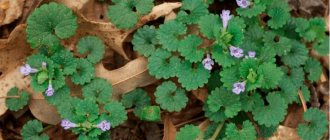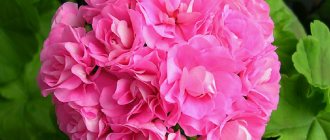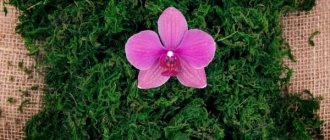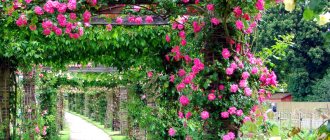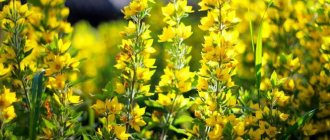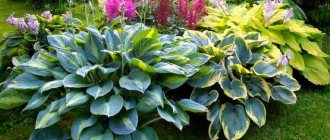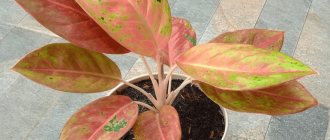Hostas are very beautiful perennial ornamental plants, without which not a single landscape composition can do - neither in a huge park, nor in a tiny garden plot.
The beauty of hostas lies in their huge leaves, striking in their variety of shapes and colors. They create a magnificent background for other ornamental plants, and also decorate the lower tier of any flower arrangements.
There are many varieties of hostas with crinkled, blistered, wrinkled, glossy and shiny, wavy, white-edged, patterned, elongated or round and other leaves, the sizes of which vary from 10 to 90 cm.
Their colors are also striking in their diversity. There are silver-white with “camouflage” coloring, light and dark green, gold, turquoise and bright blue, smooth and painted with amazing patterns. Sometimes you can find three-colored (and even four- and five-colored) hostas with amazing patterns.
Compared to the luxurious leaves of the hosta, their thin racemose inflorescences, collected from small funnel-shaped flowers of different colors, look much more modest, so when creating some compositions, designers simply remove them.
Hostas love shade and moist soil, and at the same time can go without water for a long time. The main thing is that direct sunlight does not fall on the leaves. In the wild, they tend to grow along the banks of rivers and lakes in the shade of taller bushes and trees.
This plant is unpretentious, frost-resistant and does very well in any weather anomalies. Hosta is called the “queen of shady gardens.” And indeed, she feels great in the shade. Its leaves become more powerful, and their color becomes more intense and brighter.
Experts recommend choosing a place in the garden for the hosta where it would be illuminated by the sun for no more than four hours a day.
In this article we will tell you how and when to plant hosta, how to care for it and help you choose the most beautiful and unpretentious varieties for your site.
Benefits of using hostas for garden decoration
Hostas (funkias) are quite popular plants that can often be found in the garden. The secret to their widespread use is this:
- Unpretentiousness in cultivation - these flowers do not require any special conditions or soil components.
- The plant is a real long-liver - it grows and blooms successfully in the country for 20 years, and sometimes more.
- It is not for nothing that Hosta is considered the queen of shade - it prefers semi-shaded or even heavily shaded places, so it can be used in almost any part of the garden.
- Greenery can have different shapes (round, heart-shaped, narrowed) and surface characteristics (smooth, wrinkled, matte, grooved, etc.), so it goes well with a wide variety of colors.
- In addition to garden design, hostas (especially their green part) are used in creating beautiful flower bouquets.
- Plant varieties are extremely diverse in stem height (some grow up to 19-20 cm, others can rise up to a meter). Thanks to this, you can create a wide variety of flower arrangements.
Important! Since hostas live and decorate the site for a very long time, gardeners initially carefully determine the place where the plant will feel most comfortable. To do this, you can plant 2-3 identical flowers in places with noticeably different conditions (shade, soil, level above the ground) and see after a year where the flowers are most bright and where the greenery grows the most.
Reproduction methods
Growing hosta in the garden, including its propagation, is a fairly simple procedure that even a novice gardener can carry out. If planting is planned using seeds, then the optimal period for this is April. When dividing the bush and cuttings, hosta can be propagated both in spring and summer. It is not forbidden to divide a perennial bush at the beginning of autumn.
Seeds
Hosta has dark brown seeds that can reach 1 cm in length. They are formed in small yellow oblong boxes.
After the boxes turn brown and the process of drying begins, planting material can be collected.
Immediately before planting, the seeds should be thoroughly dried at a temperature of at least +30°C. After cleaning the seeds from the lionfish, they must be placed in the refrigerator for a month. Planting material should be deepened into the soil by 6-7 mm.
Cuttings
Propagation of ornamental shrubs by cuttings is in greater demand than planting by seeds. This is due to the fact that the propagated plant retains all the properties characteristic of the mother bush.
The best time for cuttings is summer, from the end of June to the first days of July.
After planting the cuttings in the ground, it is necessary to provide them with proper care - water them regularly, and also spray the leaves with water if the plant is in the shade. Active plant growth will be achieved in a couple of weeks.
Dividing the bush
This method is suitable for mature, mature plants that have lived in one place for at least 6 years without replanting. This propagation method is ideally carried out in April-May, but autumn seeding is not critical.
To propagate, an adult bush should be completely dug up, divided into parts, keeping 2 growth points for each plant. The planting site should be filled with charcoal, and if there is a risk of groundwater rising, line the hole with drainage. After planting the plant, the soil should be thoroughly shed without affecting the foliage.
Choosing a location and optimal growing conditions
Choosing a place for a flower is very important, because it is supposed to be planted not for 1 season, but for a long time. It is better to take care of growing conditions in advance, taking into account the following rules:
- Different varieties of the “queen of shadows” have a common property: they love shaded conditions with inconsistent sunlight. Therefore, their flower beds are often located near garden trees or outbuildings. The fact is that if you plant flowers in an open area, then strong sun can have a bad effect on the coloring of the greenery - over time it will become paler, and burns may also appear.
- Hostas love moisture, so it would be optimal to plant them in low-lying areas of the garden, where moisture will accumulate after heavy rains, or near artificial reservoirs. If the summer is dry, then you will need to water frequently and abundantly - flowers do not develop well on dry soils.
- Plants should only be planted in well-dug soil. Large earthen stones must be broken. If weed rhizomes are found, they should be removed.
Important! The decision to choose a location must be made taking into account the characteristics of a particular hosta variety. For example, varieties with rich green leaves like strong shade, while plants with yellow-orange shades of green prefer semi-shade. For them, the best option would be a place that is well lit in the morning and almost completely goes into shade during the day.
To delimit zones
In addition, with the help of hosts, you can highlight and delimit individual zones on the site. For example, by planting a row of medium or several large hostas, you can separate the recreation area from the rest of the area. Of course, such plantings can hardly be called a full-fledged green hedge, but in this case the task is to “mark out” and designate the allocated territory.
The note. If you still want to create a green hedge, then you can add a number of larger plants to the hostas. From personal experience I will say that small coniferous plants, for example, juniper, are excellent for this.
Photo gallery
Features of caring for plants at different times of the year
There are a number of recommendations on how to care for hostas. Use simple tips to make the plant feel great and delight with its luxurious flowers.
in spring
This is the time for planting and propagation of the fungus, as well as active feeding. To stimulate plant growth after a hard winter, you should water the soil with urea.
In summer
The main principle of caring for hosta in summer is frequent watering and weeding. If the leaves wither and dry out, then it is necessary to carry out sanitary treatment. The soil can be loosened carefully, the main thing is not to damage the roots. Peduncles can be trimmed after the flowering period has ended. It will not be superfluous to fertilize with complex fertilizers.
in autumn
In autumn, the plants are pruned at the root, after which the rhizome is completely covered with old leaves. You can use compost. Finally, the plant must be covered with agrofibre.
in winter
Hosta care is not required in winter.
Hostas in solitaire plantings
One of the features of the hosta, which distinguishes it from many other ornamental plants, is that it is completely self-sufficient in order to be used in individual plantings. Such plantings are also called solitary plantings. For this method of decoration, varieties with large bushes and bright greenery that contrast against the general background of the garden are suitable.
Solitaire hosta plantings can be used for the following purposes:
- planting in corners of the garden to define natural boundaries;
- seating on elevated surfaces allows you to visually make the hosta even larger, which emphasizes its flowers especially well;
- finally, an excellent option for solitary planting is semi-empty places where there are no other plants nearby; thus not only filling the void, but also highlighting the funkia flowers.
Important! When carrying out such planting, you need to prepare the soil well - it is advisable to make the area level and plant small greenery on it to create a beautiful background against which the dark foliage of the plant will contrast well.
Along the paths
Hostas can also be planted along paths. This will help smooth the transition between artificial elements, such as stone tiles, and other plants.
Advice. Avoid planting hostas with large leaves too close to paths. Otherwise, when it rains, the weight of the water may cause the leaves to end up on the road, where they may be accidentally damaged by a passing person.
Options for using hosts in landscape design
The variety of varieties allows them to be successfully integrated into gardens with a wide variety of designs. You can use flowers to create classic flower beds, plant them in combination with other plants, or create entire multi-tiered compositions that well organize the interior space of the site. Everything mainly depends on the gardener's ideas. In this case, the height of the plant is of great importance - large ones are often planted singly, and small ones serve as the basis of a flower arrangement. Here are just some design moves that can be used when planting hostas:
- Planting small bushy hostas (no more than 20-25 cm in height) in a continuous strip is well suited for emphasizing slopes, in the corners of the garden, as well as for rockeries (small rocky flower beds of various shapes). Such low species are also called ground covers - they perfectly hide the soil and create the effect of a green root. Also, in the shade of their thick leaves, some weeds die from lack of light
- Varieties with a height of 28-30 cm are well suited for creating green borders. They can be planted both around the perimeter of the garden and on the internal borders that separate one group of flowering plants from others.
- Hostas with an average stem height (up to half a meter) are often used to create compositions with other varieties or other crops. They highlight tall and medium-sized plants well (especially lilies and gladioli).
- Taller plants (from half a meter to 60-70 cm) are often used for planting along ponds and garden paths. They create a framing effect that visually highlights the paths. They also form a background for taller flowers.
- The tallest hostas are used in solitaire plantings, as discussed above. They also fit harmoniously into rock gardens - among the large stones, the image of a large branched tree growing in the mountains is created. In addition, against the background of light stones, the plant contrasts well due to its dark greenery.
- A hosta flowerbed can be created from plants that are uniform in height, or from plants that are different. The latter option is often more interesting, since you can create a multi-tiered composition with a gradual increase in height from the edges to the center. This allows you to feel the effect of movement and organize the space of the flowerbed on which you can plant other flowers.
Along the walls of the house
Often, hosts are used to disguise not the most beautiful parts of the building, for example, the bottom of a wall, blind area or gutter. In this case, they are planted in front of the masked elements, as close to them as possible. Giant species of hosta, whose height reaches or even exceeds 70 cm, are best suited for these purposes.
Important! Sometimes such aspirations for beauty lead to violations of building codes, for example, to a narrowing of the blind area. This cannot be done! Beauty is, of course, important, but these standards are not written just like that.
What hosta goes with: choosing plant companions
Along with many of the advantages discussed, the hosta has one more: it does not compete with other plants and gets along well with most of them. The only exceptions are those who love an abundance of light. For example, roses require a lot of sun, and hostas, as already mentioned, prefer partial shade or even strong shade, so they are not grown together.
Among other colors, funkia goes well with the following:
- ferns;
- conifers;
- geraniums;
- lungwort;
- primrose;
- digitalis;
- Horny goat weed;
- astilbe;
- gladioli.
It can not only highlight their bright flowers, but also show their beautiful sides due to the contrast of greenery (for example, against the backdrop of bright green ferns).
How to care for hostas: preparing for winter
In the fall and winter, hostas go into a dormant state and will not grow. When fall arrives, prune your hostas by trimming away any dead or yellow leaves. Dying leaves can still absorb nutrients from the plant, so you can help hostas conserve energy for the winter by removing these leaves right away in late summer.
Hostas that grew in containers must be buried in the garden for the winter.
Hostas are hardy plants and will survive the winter, but they will have a better chance of thriving if you prepare them for the colder months. After the ground freezes, cover the soil around the hosta with fallen leaves and build such a hut for all first-year beginners.
Leave the hostas under this cover until the last spring frost.
Compositions from hostas and other plants
When creating compositions, it is important to take into account not only the design of the future flower bed, but also the matching growing conditions (abundance of moisture and shelter from direct sunlight)
Flowerbeds with heucheras and hostas
The composition of hosta with heuchera is one of the most successful options of its kind. This is explained by the fact that heuchera has flowers of delicate light shades (from white to red). They stand out well thanks to the juicy, dense greenery of the funkia. When creating a composition of these crops, it is important to take into account that heuchera grows up to half a meter in height, so it can be planted in various combinations with low-growing hosta. If the choice fell on large and tall hostas (from 80 cm to a meter), then they should always be planted in the background so that the heuchera does not get lost in their bushes.
Hostas in combination with astilbes
Astilbe and hosta share a love for shade, which is why they are often used together when creating compositions. The options for their use are limited only by the gardener’s imagination. Here are just a few of them:
- Create a beautiful garden frame using alternating hostas and astilbes.
- Arranging a flower arrangement to create a border along garden paths or ponds.
- An excellent option is a circular composition around a shady garden tree, which will fill the empty space underneath it.
- Finally, such compositions are often used to frame a lawn with even greenery in bright shades.
Other flower arrangements
Hosta fits into flower beds and other types of compositions with many plants, since varieties have different stem heights.
Basically, design moves are based on 2 ideas:
- Contrasting bright colors against the background of dark green hostas - gladioli, lilies, irises, delphiniums. The plant also contrasts well against the background of soft green foliage (small lawn vegetation, ferns).
- Creating multi-tiered compositions with height differences due to hostas and other plants. For example, the same gladioli can be placed in the background, and small varieties of hosta can be grown right in front of them. This will create the effect of upward movement due to the tiering and shape of the gladioli flowers.
Functionia can be used in a variety of ways, since there are many types of plants, and each of them has its own characteristics. At the same time, caring for the plant will not be difficult, so hosta is the choice of many gardeners, both among amateurs and professionals.
What varieties are considered decorative?
Lush “pillows”, as if woven from dove, blue and golden leaves, can bring extraordinary colors to the garden’s palette.
Perhaps the most common variety, which has long taken root in suburban areas, is hosta plantain. The plant, decorated with large light green leaves, is capable of forming “pillows” 60-80 cm high
Breeders never cease to amaze, creating new varieties that amaze with the contrast of shades and texture of foliage. Two and even three-colored hostas are the most decorative.
Recent Entries
Lilac perennials that are beautiful, compact and do not crowd out other plants Why when buying seedlings you should not take the sellers’ word for it and how to determine the age of the plant using 3 signs Tomato seedlings have turned purple or whitish: why the color has changed and how to save the plants
'Whirlwind' with white leaves edged with an apple-green outline is a striking representative of the tricolor varieties of perennial beauties
The 'Striptease' variety looks no less impressive, decorated with an elegant whitish stripe breaking through the center of the leaf through a rich, wide dark green border.
One of the latest trends in hosta breeding is the creation of varieties with a wavy edge of the leaf blade.
The varieties 'Medusa', decorated with a clump of green-yellow foliage, and 'Hadspen Heron' with bright green fan-shaped leaves have a special charm.
A feature of varietal plants is their slow mass growth. Such hosts acquire sufficient decorativeness only at the age of 4-5, and are able to fully demonstrate their beauty only at the age of 8-10 years. Gradually, from year to year, forming larger and larger leaves, which acquire the color and shape characteristic of the variety, small, inconspicuous bushes turn into real “queens of the flower garden.”
Classification
There are several groups based on the external characteristics of both wild and hybrid species. The gradation of plants depends on size. According to the American classification, the following groups can be distinguished:
- dwarf - height does not exceed 10 centimeters;
- miniature – grow up to 15 centimeters;
- small - plants up to 25 centimeters;
- medium - grow up to half a meter;
- large – these hostas can reach 70 centimeters in height;
- gigantic - over 70 centimeters.
There are hosts that belong to intermediate groups of this classification.
In addition to size, the following features may be taken into account:
- leaf shape – round, oval, elongated, heart-shaped;
- type of leaf surface - corrugated, matte, glossy, wavy, bronze-metallic;
- green color – white, golden, gray and blue shades, deep green.
Pests, diseases
During the growth of the hosta, it is affected by various diseases, and gardeners constantly observe insect attacks:
| Pest/disease | Symptom (effect on foliage) | Elimination methods |
| Phyllostiosis | Red-brown spotting. | All diseased leaves are cut off and thrown away. Shrubs are sprayed with Vectra or Abiga-Peak, and colloidal sulfur is often used. |
| Botrytis | Rotting. | Treat with Bordeaux mixture or Topaz. The affected parts are destroyed. |
| Root collar rot | The rhizome is affected. | They dig it up, wash the root system, remove infected areas, and dip it in a light solution of potassium permanganate. Transported to a new location. |
| Slugs | Traces of dried mucus, holes. | A Thunderstorm bait is placed under the flower, covered with plywood in the evening, and pests are collected manually in the morning. |
| Foliar nematodes | Light brown spots. | The affected areas are destroyed. The soil is sprayed with a formaldehyde solution or the flower is moved to a new area, but the roots are first soaked in potassium permanganate. |
With timely detection of diseases and insects, the flower pleases with its flowering for a long time.


